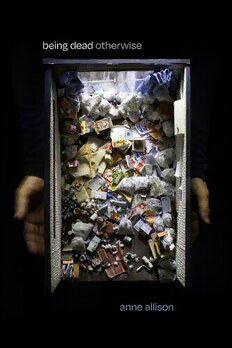
Being Dead Otherwise PDF
Preview Being Dead Otherwise
being dead other wise A stone marker for disconnected dead at Tama Reian Cemetery, Koganei, Tokyo being dead other wise anne allison duke university press durham and london 2023 © 2023 duke university press All rights reserved Printed in the United States of Amer ic a on acid- free paper ∞ Proj ect Editor: Lisa Lawley Designed by Matthew Tauch Typeset in Alegreya Regular and Degular by Westchester Publishing Services Library of Congress Cataloging- in- Publication Data Names: Allison, Anne, [date] author. Title: Being dead other wise / Anne Allison. Description: Durham : Duke University Press, 2023. | Includes bibliographical references and index. Identifiers: lccn 2022040878 (print) lccn 2022040879 (ebook) isbn 9781478019848 (paperback) isbn 9781478017141 (hardcover) isbn 9781478024415 (ebook) Subjects: lcsh: Death— Social aspects— Japan. | Death care industry— Japan. | Funeral rites and ceremonies— Japan. | Japan— Social life and customs—21st century. | bisac: social science / Anthropology / Cultural & Social | social science / Death & Dying Classification: lcc gt3284.a2 a45 2023 (print) | lcc gt3284.a2 (ebook) | ddc 393— dc23/eng/20221207 lc rec ord available at https:// lccn . loc . gov / 2022040878 lc ebook rec ord available at https:// lccn . loc . gov / 2022040879 Cover art: Kojima Miyu, Miniature Model of a Garbage House in Tokyo, 2018. Photo by Naoko Kawamura. Courtesy Asahi Shimbun/Getty Images. To Yoshiko For all you have taught me, shared with me, and accompanied me in This page intentionally left blank Contents ix Prelude xi Acknowl edgments 1 introduction histories 25 1 Ambiguous Bones: Dead in the Past 47 2 The Popu lar Industry of Death: From Godzilla to the Ending Business preparations 73 3 Caring (Differently) for the Dead 99 4 Preparedness: A Biopolitics of Making Life Out of Death departures 123 5 The Smell of Lonely Death and the Work of Cleaning It Up 149 6 De- parting: The Handling of Remaindered Remains machines 173 7 Automated Graves: The Precarity and Prosthetics of Caring for the Dead 191 Epilogue 197 notes 215 BiBliogrAPhy 231 index viii contents prelude In a stream of new enterprises catering to death, this one washes and pulverizes human remains. Called a “bone busi- ness” (hone- ya-san), the comp any is small and sits quietly in a residential neighborhood in Tokyo. But t hings are active in- side. Boxes of cremains from all over the country stand high in the main room. Posted straight from the crematorium or dug up from ancestral graves and destined for reburial in an urban cemetery, the ashes have traveled h ere to be further compacted. W hether to be scattered in the sea (sankotsu) or in- terred in a high- rise columbarium, bone fragments are sent to be ground into fine powder (funkotsu). This is a delicate proc ess, the owner tells me, displaying the mortar and pestle he uses in the final step. The body, in death, reformulated for changing times, re- flecting a landscape where the dead don’t necessarily wind up where they used to: in a family or ancestral plot in the ground, attached to a Buddhist temple passed down for generations, and tended fastidiously by patrilineal kin. This was once sanc- tioned by law in a genealogical princi ple that sutured the nation-s tate to the continuity of the imperial system incarnated by the emperor. But alongside reforms in the postwar “demo- cratic” constitution adopted in 1947, the grave went from being a place to memorialize ancestors to a place for an individual’s eternal rest. Since then, a number of f actors have contributed to dismantling this family-b ased mortuary system even fur- ther: urbanization and sped-up lifestyles, an aging population with low birth rates, decreasing rates of marriage and cohabi- tation, the rise of Japa nese citizens living and dying alone, and a shift away from long- term employment to more irregular
